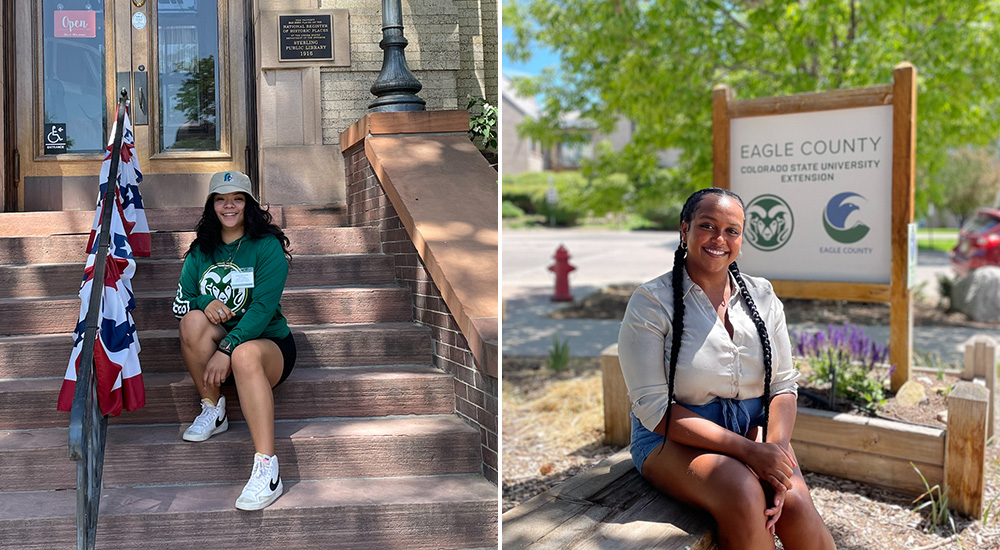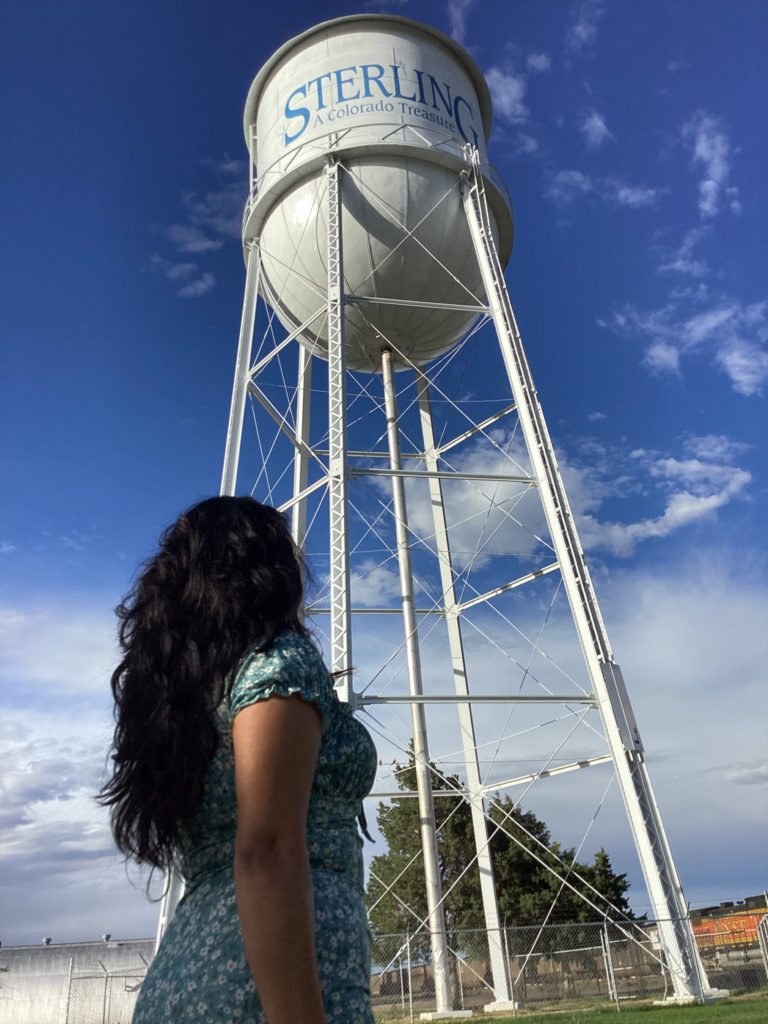Part of a special series highlighting College of Liberal Arts students and their summer internships with CSU Extension

At face value, the phrase visita de doctor seems as ordinary as doctor’s appointments usually are: waiting rooms with coffee tables stacked with magazines to flip through, clipboards of paperwork to fill out, and delays for appointments that should have started already.
Culturally, visita de doctor means something else entirely. For many native Spanish speakers, visita de doctor, implies a quantity over quality problem when it comes to patient care – getting patients in and out quickly rather than allowing them to discuss their health concerns.
“It’s like 5-10 minutes, ‘OK, what do you need? OK. Prescription. Alright, let’s go. See you in two weeks.’ And then it doesn’t even give them room to talk about their concerns,” says CSU Extension intern and Spanish student, Giselle Alpizar-Calixto.
The language and cultural barriers between healthcare professionals and their Spanish-speaking patients has become an opportunity for educating students in CSU’s Department of Language, Literatures, and Cultures (LLC) through the Language for Specific Purposes concentration where Spanish for healthcare courses and learning modules better prepare students for science and healthcare related fields.
To help build language bridges instead of barriers, seniors Abi Tekeste and Giselle Alpizar-Calixto, applied to be interns with CSU Extension in “Spanish in Professional Environments,” where they interviewed dozens of monolingual Spanish speakers in rural communities, to both better understand where these language gaps exist in healthcare, as well as provide information to these communities so they can make more informed decisions regarding their healthcare.
“Spanish in Professional Environments” is a project led by LLC’s Associate Professor of Spanish Andrea Purdy and CSU Extension to collect information on healthcare sentiments and healthcare access of rural Spanish-speaking populations, in this case, Eagle and Logan Counties. “You need to understand when these breakdowns happen. Where do the breakdowns occur?” “What cultural knowledge do they need to be able to understand when they reply to something?” Purdy said.
The project is built to be symbiotic: as the information is collected from interviews with the county’s residents, the interns inform community members of existing healthcare options. “I think what we’re doing is very revolutionary – including the [Spanish-speaking] community members’ perspective,” Purdy says.
The enthusiasm and drive from Purdy to improve the skill sets of students but also the lives of Colorado’s Spanish speaking population is not lost on Tekeste or Alpizar-Calixto and is partly what inspired them to push their Spanish skills even further as part of their internship.
Aside from the inspiration Tekeste finds from Purdy’s enthusiasm, the most prominent factor driving Tekeste’s involvement is her deeply rooted compassion for others, developed in part from immigrating to the US at age 14 from Kenya, and in part from her life-long understanding of the vitalness of community.
“I’m here because my family is so community-based. I’ve been raised in a way of thinking – that you’re built on a community,” she says.
Interviewing community members in Eagle County, Tekeste, a double major in political science and international studies with a Spanish minor, met nearly 30 people from the towns of Eagle, Edwards, and Gypsum, and was surprised to find her interviewees came from a variety of Spanish-speaking countries including Chile, Honduras, and Mexico.
The next surprise for Tekeste? How much cultural differences played into the interviews.
“We kind of start to place people and generalize them based on a language that they speak, not seeing beyond that and how there’s different cultural aspects that just because someone speaks Spanish, they’re not from Mexico. And these days, some people tend to generalize a lot based on that.”

Another cultural nuance that showed up in these interviews for Tekeste was how these populations view healthcare, particularly preventative care. “Not a lot of people believe in preventative care. Not a lot of people have health insurance… A lot of people won’t go to a doctor unless there’s an emergency,” she says.
Keeping those cultural differences in her periphery allowed Tekeste to build trust with the community she interviewed, gaining the insights needed to better establish what will become the Spanish in healthcare training modules accessible to current and future healthcare professionals taking courses at CSU.
“We’re in the early steps of creating that module by seeing what the community is giving us, what they want to happen during their interactions with professional healthcare workers or people in the legal field. They’re telling us what they’ve gone through and the problems that they face in their interactions,” Tekeste says.
But for Tekeste, the key component of her Extension internship is not solely about using the information to build these modules, but to give back to the Spanish-speaking community that helped her collect the information. She and CSU Extension hope to reciprocate the community’s help by presenting information on what healthcare options are available to them, in part with the help of the MIRA Bus, a traveling RV providing basic health information, education, and screening in Eagle County.
“I specifically love that we’re not just going in and taking the information and leaving, but this information will go back in [to the community], and we make a change” Tekeste says.
From Eagle to Logan County | The Other Side of the State
Giselle Alpizar-Calixto shares that same pride in her internship with Extension, nearly 300 miles away in Logan County, with a population hovering just over 22,000, and over half of that population housed in the town of Sterling – the main site for Alpizar-Calixto’s interviews.
Sterling and the county’s next largest city, Fort Morgan, are agricultural communities, and have significant Spanish-speaking populations residing there for work in both towns. As rural communities already struggle for healthcare access, adding a language barrier exacerbates a growing problem as Latin-American and Hispanic populations grow in the US.

“I want to help, and I want to understand, and it shouldn’t be an issue for a lifetime. In a couple of decades Spanish won’t be just a secondary language in the U.S.,” Alpizar-Calixto says. “We just want to make sure that everyone is being heard, regardless of who you are, what language you speak, or where you come from.”
Making sure these communities have a voice when it comes to healthcare is not only an aspiration instilled through her three years as a double major in Health and Exercise Science and Spanish but as a first-generation student who grew up with Spanish as her first language, often interpreting for her parents in doctor’s offices.
“When I was eight, my mom would have me translating between the doctor and her, and I’m over here struggling in my brain to switch on and off from English to Spanish,” she recalls.
As someone who aspires to work as a physical therapist, Alpizar-Calixto sees the need to learn healthcare-specific terms in Spanish so she can help create and support the courses of the Language for Specific Purposes concentration – an essential part of creating the next generation of professionals like her who can offer non-English speakers a voice.
“I really appreciated how this internship gave a community a voice,” Alpizar-Calixto says. “They (the interviewees) would just keep thanking me for my work was doing, and I was like, ‘No, thank you for being here.’ It’s teamwork.”
Internships: The Practical and Applied Side of the Liberal Arts
The CSU Summer Extension Internship program gives students the opportunity to take their research and expertise into the field to help communities across Colorado in the areas of Natural Resources and Sustainability, Food and Agriculture, Youth Development, Economic and Community Development, Health and Well-Being, and Emergency Planning and Resources.
In summer 2022, the College of Liberal Arts had 18 students participate in an Extension internship.